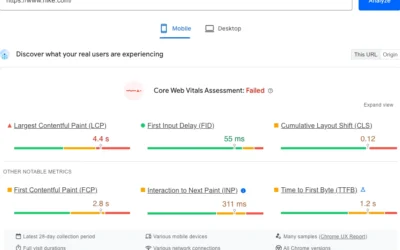A Step by Step Guide to hreflang for SEO

Mastering Hreflang for SEO
In today’s global economy, having a strong online presence is essential for businesses of all sizes. With so many websites competing for attention, it’s important to optimize your site to reach the right audience. One important aspect of SEO that often gets overlooked is hreflang, which is a tag used to indicate the language and regional targeting of a webpage. Implementing hreflang tags on your website can help you reach the right audience and improve your search engine ranking. In this post, we’ll provide a step-by-step guide to auditing your website’s hreflang tags to ensure that your website is optimized for global SEO. Whether you’re a digital marketer, website owner, or SEO specialist, this SEO beginners guide will provide you with the tools you need to master hreflang SEO and take your website to the next level.
What is hreflang?
When it comes to optimizing your website for international audiences, hreflang SEO plays a crucial role. Hreflang tags help search engines understand the language and geographic targeting of your website pages, ensuring that the right content is shown to the right users in search results.
But what exactly is hreflang SEO?
In simple terms, it is an HTML attribute that helps search engines identify the language and location targeting of different versions of your web pages. This is particularly important for businesses operating in multiple countries or targeting diverse language-speaking audiences.
The importance of hreflang SEO cannot be overstated. Without proper implementation, search engines may misinterpret your content and display the wrong language or location-specific pages to users. This can lead to a poor user experience and ultimately affect your website’s visibility and rankings in international search results.
By implementing hreflang tags correctly, you can ensure that search engines correctly identify and serve the most relevant version of your content to users based on their language and location preferences. This not only improves user experience but also increases the likelihood of attracting organic traffic from your target audience.
In this comprehensive website audit guide, you will learn a step-by-step process of mastering hreflang SEO. From understanding the basics to implementing hreflang tags effectively, you will gain valuable insights and actionable tips to optimize your website for international visibility and success.
Ready to take your SEO to the next level?
Now that you have read about SEO on the blog, it’s time to plan your next move. Please book a strategy session, and we can discuss your plan of action.
Understanding the basics of hreflang tags
Understanding the basics of hreflang tags is essential for any website owner or SEO professional looking to optimize their website for international audiences.
Hreflang tags are HTML attributes used to indicate the language and geographical targeting of a specific webpage. These tags play a crucial role in helping search engines understand which version of a webpage should be shown to users based on their language preferences and location.
To implement hreflang tags correctly, you need to consider a few key factors. Firstly, it’s important to determine the language and region variations of your content. This means identifying the languages you want to target and the specific regions within those languages that you want to focus on.
Once you have identified your target languages and regions, you can begin implementing the hreflang tags. These tags are typically placed in the head section of your HTML code and should be included on all relevant pages of your website.
The hreflang tag consists of two main components: the language code and the optional country/region code. The language code follows the ISO 639-1 standard, while the country/region code uses the ISO 3166-1 Alpha 2 format. For example, “en” represents English, while “en-US” refers to English spoken in the United States.
To ensure accurate implementation, it’s crucial to use the correct language and region codes in your hreflang tags. Mistakes or inconsistencies can lead to search engines misinterpreting your intended audience, resulting in incorrect targeting or even penalties.
Additionally, it’s important to note that hreflang tags should be reciprocal. This means that if you have a page targeting a specific language and region, there should be a corresponding page on your site targeting the same language and region.
By understanding the basics of hreflang tags and implementing them correctly, you can improve the targeting and visibility of your website for international users. This can lead to increased organic traffic, improved user experience, and ultimately, better conversions and business growth.
Audit website structure to identify hreflang opportunities
Before diving into the intricacies of hreflang SEO, it’s crucial to conduct a thorough analysis of your website structure. This step is essential as it allows you to identify potential hreflang issues that may hinder your website’s performance in search engine rankings.
Start by examining your website’s architecture and navigation. Ensure that your website is organized logically and intuitively, with clear categorization and hierarchy. This will help search engines understand the structure of your site and improve user experience.
Next, focus on identifying any potential hreflang issues. Hreflang tags are HTML attributes that indicate the language and geographical targeting of a specific webpage. These tags play a crucial role in ensuring that search engines correctly interpret and display your website to the right international audience.
Check if your hreflang tags are implemented correctly across your website. Look for any missing or incorrect tags that could lead to confusion for search engines. Ensure that each page has the appropriate hreflang tag pointing to the relevant language and country version of that page.
In addition to checking the presence and accuracy of hreflang tags, it’s also important to assess the consistency of language and country targeting across your website. Ensure that your content aligns with the targeted audience for each specific page. This can include using the appropriate language, currency, and local references.
Furthermore, pay attention to any potential conflicts or overlapping hreflang tags. If multiple pages have conflicting hreflang attributes, search engines might struggle to determine the correct version to display, resulting in lower visibility and potential ranking issues.
By thoroughly analyzing your website structure and identifying potential hreflang issues, you lay a strong foundation for effective hreflang SEO implementation. This step sets the stage for ensuring that your website accurately targets the right international audience, ultimately boosting your visibility and organic traffic from different regions which will provide the best user experience which helps your SEO.
Ready to take your SEO to the next level?
Now that you have read about SEO on the blog, it’s time to plan your next move. Please book a strategy session, and we can discuss your plan of action.
Conducting an in-depth keyword analysis for different language and regional variations
When it comes to optimizing your website for different language and regional variations, conducting an in-depth keyword analysis is crucial. This step will help you understand how users in different regions and languages search for products or services similar to yours.
Start by identifying the target languages and regions for your website. This could be based on your target audience or the countries where you operate. Once you have this information, you can begin researching keywords specific to each language and region.
There are several tools available to assist you in this process. Google Keyword Planner is a popular choice, as it provides insights into search volume and competition for specific keywords. Additionally, tools like SEMrush and Ahrefs offer comprehensive keyword research capabilities and can help you identify relevant keywords in different languages.
When conducting your keyword analysis, consider not only the search volume but also the intent behind the search. Different languages and regions may have unique search behaviors and preferences. Pay attention to long-tail keywords, as they often provide more specific and targeted search results.
It’s important to remember that language and regional variations may have different search terms for similar products or services. For example, while “running shoes” might be a popular search term in English-speaking countries, the equivalent term in Spanish-speaking countries may be “zapatillas para correr.” Adapting your keyword strategy to accommodate these variations will ensure that your website appears in relevant search results for each target language and region.
Once you have compiled a list of keywords for each language and region, it’s time to optimize your website accordingly. This involves incorporating the selected keywords into your website’s content, meta tags, URLs, and other relevant elements. By doing so, you’ll help search engines understand the language and regional targeting of your website, ultimately improving its visibility in search results.
Conducting an in-depth keyword analysis for different language and regional variations is a critical step in mastering hreflang SEO. It ensures that you are targeting the right keywords for each audience, enhancing your website’s visibility and attracting relevant organic traffic.
Evaluating your existing hreflang implementation and identifying errors or inconsistencies
Once you have a basic understanding of hreflang and have implemented it on your website, it is crucial to regularly evaluate its effectiveness and identify any errors or inconsistencies that may be affecting its performance. Conducting a thorough audit of your hreflang implementation will help ensure that search engines correctly interpret and display your content to the right international audiences.
Start by reviewing your website’s HTML code and inspecting the hreflang tags. Check if the hreflang attribute is properly implemented on all relevant pages across different language and regional versions of your site. Look for any missing tags, incorrect language or country codes, or duplicate tags that may confuse search engines.
Next, analyze your XML sitemap(s) to ensure that all language and regional versions of your pages are included and accurately referenced using hreflang tags. Verify that the URLs listed in your sitemap correspond to the correct language and country versions.
In addition to reviewing the technical implementation, it is important to check the consistency of your hreflang annotations across your website. Ensure that the language and country codes used in the hreflang tags align with the language and country targeting specified in your content. Inconsistencies can lead to confusion and incorrect indexing by search engines.
Consider utilizing specialized tools and software that can help automate the process of evaluating hreflang implementation. These tools can quickly analyze your website’s hreflang tags, detect errors, and provide recommendations for improvement.
During the evaluation process, keep an eye out for common hreflang errors, such as missing self-referencing tags, incorrect language or country codes, mismatched URLs, or inconsistent annotations. Correcting these errors will enhance the accuracy of your hreflang implementation and improve your website’s visibility in international search results.
Regularly monitoring and auditing your hreflang implementation is essential for maintaining a strong international SEO strategy. By identifying and rectifying any errors or inconsistencies, you can ensure that your website effectively targets the right international audiences and maximizes its organic search visibility across different regions and languages.
Ready to take your SEO to the next level?
Now that you have read about SEO on the blog, it’s time to plan your next move. Please book a strategy session, and we can discuss your plan of action.
Implementing hreflang tags correctly on your website
Implementing hreflang tags correctly on your website is a crucial step in mastering hreflang SEO. These tags help search engines understand the language and geographical targeting of your content, ensuring that the right version of your website appears in the appropriate search results for different regions and languages.
To implement hreflang tags correctly, you need to consider a few key factors. First, identify all the different language and regional versions of your website. This could include variations such as English-US, English-UK, Spanish-Spain, Spanish-Latin America, and so on. Then, map each version to its corresponding URL.
Next, ensure that the hreflang tags are placed in the head section of your HTML code. Each tag should contain the language and region code, as well as the URL of the corresponding version of your site. For example, a hreflang tag for the English-US version of your website would look like this:
Make sure to include these tags on every relevant page of your website, including the homepage, category pages, and individual content pages. This helps search engines understand the language and regional targeting of each specific page.
Additionally, it’s essential to correctly indicate the default language and region of your website. This is done by adding a rel=”alternate” hreflang=”x-default” tag to the homepage URL. For example:
Once you have implemented the hreflang tags correctly, it’s important to regularly monitor and test them to ensure they are functioning as intended. Use tools like Google Search Console and hreflang validation tools to check for any errors or inconsistencies.
By implementing hreflang tags correctly, you can improve the visibility of your website in search results across different languages and regions. This not only helps you reach a wider audience but also enhances the user experience by presenting content that is relevant and localized to each user.
Verifying and testing your hreflang implementation for accuracy
Once you have implemented hreflang tags on your website, it is crucial to verify and test their accuracy to ensure that they are functioning as intended. This step is essential in ensuring that your international SEO efforts are successful and that search engines can correctly interpret and display your website’s content to the appropriate regional audience.
To begin, you can use various online tools specifically designed for hreflang verification. These tools will crawl your website and check if the hreflang tags are correctly implemented and if there are any errors or inconsistencies. They can also help identify missing or incorrect language and country codes, as well as any URLs that are not properly included in the hreflang annotations.
Once you have identified any issues, it is important to address them promptly. Start by checking the source code of your web pages to ensure that the hreflang tags are present and properly formatted. Pay close attention to the language and country codes, as even a small mistake can impact the accuracy of your hreflang implementation.
Next, it is recommended to manually test your hreflang implementation by using a search engine. Perform searches for your targeted keywords in different regions and languages to see if the search results display the correct localized versions of your web pages. This will help you confirm that the hreflang tags are working as intended and that search engines are correctly understanding the language and geographic targeting signals of your website.
Additionally, consider using the Google Search Console to further verify your hreflang implementation. The International Targeting report within the Search Console can provide insights into any errors or issues detected by Google regarding your hreflang tags. It is advisable to regularly monitor this report and address any identified problems promptly.
Regularly reviewing and testing your hreflang implementation is crucial to maintain the accuracy and effectiveness of your international SEO efforts. By taking the time to verify and test your hreflang tags, you can ensure that your website is providing the right content to the right audience, ultimately improving your website’s visibility and organic traffic from different regions and languages.
Monitoring and maintaining your hreflang tags over time
Once you have implemented hreflang tags on your website, it is crucial to monitor and maintain them over time to ensure their effectiveness. Hreflang tags are not a one-and-done task; they require ongoing attention and management to guarantee optimal performance.
Regularly monitoring your hreflang tags will help you identify any potential issues or errors that may arise. This can be done through various methods, such as using SEO auditing tools or manually checking your website’s source code. Look out for any missing or incorrect hreflang attributes, as these can lead to misinterpretation by search engines and result in incorrect language or regional targeting.
In addition to monitoring, it is essential to maintain your hreflang tags as your website evolves. This includes updating them whenever you add or remove pages, launch new language or regional versions of your site, or make changes to your existing content. By keeping your hreflang tags up to date, you can ensure that search engines accurately understand the language and geographic targeting of your website’s pages.
Regularly reviewing and refining your hreflang implementation will not only improve the user experience for your international audience but also help search engines properly index and display your content in the right regions and languages. This can lead to increased visibility, organic traffic, and ultimately, higher conversions.
Remember, mastering hreflang SEO requires ongoing dedication and attention to detail. By monitoring and maintaining your hreflang tags over time, you can stay ahead of any potential issues and optimize your website’s international targeting for long-term success.
Ready to take your SEO to the next level?
Now that you have read about SEO on the blog, it’s time to plan your next move. Please book a strategy session, and we can discuss your plan of action.
Common challenges and troubleshooting tips for hreflang SEO
Implementing hreflang tags on your website can greatly improve its international SEO performance. However, as with any technical implementation, there are common challenges that may arise. In this section, we will discuss these challenges and provide you with valuable troubleshooting tips to ensure a seamless hreflang SEO strategy.
One of the most common challenges is incorrect implementation of hreflang tags. It is crucial to ensure that the hreflang tags are placed accurately on each page of your website. A small error, such as misspelling a language or country code, can lead to ineffective or incorrect targeting. To troubleshoot this issue, carefully review your hreflang tags and compare them with the language and country codes specified by search engines.
Another challenge is dealing with dynamically generated content. Websites that generate content dynamically, such as e-commerce platforms, may face difficulties implementing static hreflang tags. In such cases, it is recommended to use server-side solutions or consult with your development team to ensure that the hreflang tags are correctly implemented and dynamically updated as needed.
Hreflang conflicts can also arise when multiple versions of your website exist, such as www and non-www versions, HTTP and HTTPS versions, or different subdomains. These conflicts can confuse search engines and lead to incorrect language or regional targeting. To troubleshoot this issue, set up proper canonicalization, redirect the non-preferred versions to the preferred version, and ensure consistent implementation of hreflang tags across all versions.
Additionally, it is essential to regularly monitor and update your hreflang tags. Websites undergo changes over time, such as adding or removing pages, launching new language versions, or restructuring content. Failure to update hreflang tags accordingly can result in outdated or broken targeting. To prevent this, establish a process for regularly auditing and updating your hreflang tags to align with any changes on your website.
By being aware of these common challenges and following the troubleshooting tips provided, you can master hreflang SEO and ensure accurate targeting for your international audience. Remember, attention to detail and ongoing maintenance are key to optimizing your website’s hreflang implementation.
Conclusion and final thoughts on mastering hreflang SEO
In conclusion, mastering hreflang SEO is crucial for businesses that operate in multiple languages or target international audiences. It ensures that search engines correctly understand and index the various language versions of your website, leading to improved visibility and targeted traffic.
Throughout this step-by-step website audit guide, we have covered the key aspects of implementing hreflang tags effectively. From understanding the purpose and benefits of hreflang to conducting comprehensive keyword research and analyzing your website structure, each step plays a vital role in ensuring the success of your hreflang SEO strategy.
By following the best practices outlined in this guide, you can avoid common pitfalls and maximize the impact of hreflang tags on your website’s search engine rankings. Remember to regularly monitor and update your hreflang implementation as your website evolves and expands to new markets or languages.
Additionally, it is essential to keep up with the latest industry trends and algorithm updates to stay ahead of the competition. Search engines are constantly evolving, and staying informed about the changes in their ranking algorithms will help you adapt your hreflang SEO strategy accordingly.
In conclusion, mastering hreflang SEO requires continuous effort, attention to detail, and a thorough understanding of your target audience and market. However, the rewards are well worth it, as achieving accurate language targeting and improved search engine visibility can significantly boost your website’s organic traffic and ultimately drive business growth.
So, take the time to audit your website, implement hreflang tags correctly, and monitor the results. With dedication and perseverance, you can master hreflang SEO and unlock the full potential of your international website.

Shane Hampson
Ethical SEO Consultant
Data Driven Marketer. Fantasy Football Champion. Dog Lover. Foodie.
Ready to take your SEO to the next level?
Now that you have read about SEO on the blog, it’s time to plan your next move. Please book a strategy session, and we can discuss your plan of action.
Recent Blog Posts
Can you use interstitials for SEO?
What are interstitials and are they good for SEO? Should you avoid intrusive interstitials? What does Google say?
Using PreLoad, PreConnect and Prefetch for SEO
Learn how to use pre-load, pre-connect and pre-fetch to boost your SEO site speed and Core Web Vitals.
How To Optimize For Core Web Vitals
Core Web Vitals are a set of specific factors that measure loading performance, interactivity, and visual stability of a web page, and they are crucial for providing a good user experience and improving SEO.



